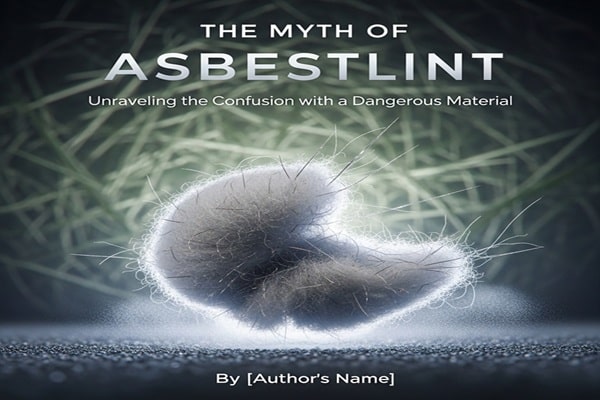If you’ve stumbled across the word “asbestlint” while researching home renovations, digging into historical documents, or even scrolling through a European construction forum, you probably paused and wondered: What on earth is that?
At first glance, it sounds like a product brand or some exotic building material. But here’s the truth—“asbestlint” isn’t a new discovery or a mystery substance at all. Instead, it’s a term rooted in translation that points straight back to one of the most dangerous building materials ever used: asbestos.
In this guide, we’ll break down what “asbestlint” actually means, its real-world uses, why it poses serious health risks, and—most importantly—what you should do if you find it in your home or workplace.
What Does “Asbestlint” Really Mean?
The name itself gives us the biggest clue:
-
“Asbest” is the word for asbestos in German, Dutch, and several Scandinavian languages.
-
“Lint” translates to “rope,” “tape,” “string,” or even “wick.”
Put those pieces together, and “asbestlint” simply means:
asbestos rope, asbestos tape, or asbestos wick.
So, it’s not a separate material. It’s a form of asbestos—woven, braided, or shaped into strips and ropes—that was widely manufactured and used during much of the 20th century.
The Rise of Asbestos Rope and Tape
Asbestos once carried the glamorous nickname “the miracle mineral.” Why? Because it resisted fire, heat, electricity, and corrosion better than almost anything else on the planet.
That made it a go-to solution in construction, manufacturing, and even household products. In its “lint” form (tapes, ropes, and cords), asbestos became a workhorse material used in dozens of industries.
Here’s where you would typically find it:
-
Pipe & Boiler Insulation: Wrapped tightly around hot water pipes, steam boilers, and furnaces to keep heat contained and protect nearby materials.
-
Sealing & Gaskets: Stuffed into stove doors, ovens, kilns, and industrial machines to create fireproof seals.
-
Electrical Insulation: Used as a non-conductive wrap for wires and other components.
-
Plumbing & Mechanical Joints: Packed into threaded joints to withstand extreme heat and pressure.
For decades, “asbestlint” was everywhere—hidden in walls, wrapped around pipes, and tucked into machines. Unfortunately, the same qualities that made it so effective also made it one of the deadliest materials ever used.
The Hidden Danger: Why Asbestlint Is a Health Hazard
Here’s where things turn grim. Asbestos isn’t just tough—it’s toxic.
“Asbestlint,” like all asbestos products, is made up of microscopic fibers. When these materials age, fray, or get disturbed, the fibers can break free into the air.
And once inhaled, they can embed themselves deep inside the lungs. The body can’t get rid of them. Over years—even decades—those fibers cause inflammation and scarring that lead to devastating diseases, including:
-
Asbestosis: A chronic lung disease that scars tissue and makes breathing painfully difficult.
-
Lung Cancer: Strongly linked to prolonged asbestos exposure.
-
Mesothelioma: A rare, aggressive cancer of the lining of the lungs, chest, or abdomen.
What makes asbestos particularly insidious is its latency period. Symptoms often don’t appear until 20–50 years after exposure. By the time people realize they were affected, it’s often too late.
Could You Have Asbestlint in Your Home?
If your home, office, or workplace was built before the 1980s, there’s a good chance some asbestos-based products were used in its construction.
You might encounter “asbestlint” in places like:
-
Wrapping around basement or attic pipes.
-
Old furnace insulation.
-
White or gray rope-like material around stove doors.
-
Seals or gaskets in older heating appliances.
The scary part? It often just looks like old fabric, string, or tape. Many people unknowingly handle it without realizing what it is.
What NOT to Do If You Find Suspected Asbestlint
Let’s say you’re in your basement and notice some old rope-like material crumbling around your pipes. Your first instinct might be to pull it off or vacuum it up. Don’t. That’s the worst move you could make.
Here’s what you should never do:
-
Don’t touch or disturb it. Breaking it apart will release fibers.
-
Don’t sweep or vacuum it. Standard cleaning methods spread fibers into the air.
-
Don’t try a DIY removal. Asbestos is not a weekend project—it requires professional handling.
The Right Way to Handle It
If you suspect “asbestlint” (or any asbestos-containing material) in your space, here’s the safe approach:
-
Treat it as dangerous until tested. Always assume it contains asbestos unless proven otherwise.
-
Call in the professionals. Licensed asbestos abatement experts have the training, equipment, and certifications to handle it safely.
-
Testing first, removal second. They’ll run proper lab tests to confirm whether the material is asbestos. If it is, they’ll either encapsulate it (seal it off) or remove it following strict safety protocols.
-
Keep people away. Limit access to the area until it’s inspected.
Also Read : Assimilasjon: A Comprehensive Exploration of Cultural Integration and Identity
Why This Still Matters Today
Some people assume asbestos is an issue of the past. After all, it’s been banned or heavily restricted in many countries for decades. But the truth is:
-
Millions of older homes, schools, and workplaces still contain asbestos-based products.
-
Renovations, demolitions, or even simple repairs can release hidden fibers.
-
New cases of mesothelioma and asbestos-related illnesses are still being diagnosed every year.
Understanding terms like “asbestlint” isn’t just trivia—it’s a reminder of how widespread asbestos was and why awareness is still critical for protecting your health.
Final Thoughts: Knowledge Is Your Best Defense
While “asbestlint” might sound like an obscure foreign term, it’s really just another name for asbestos rope or tape—a material that left behind a dangerous legacy.
The key takeaway? If you see it, don’t touch it. Awareness and caution are your best defense against exposure. And when in doubt, always call a professional.
Because at the end of the day, your health and safety are worth far more than saving a few dollars on DIY removal.
